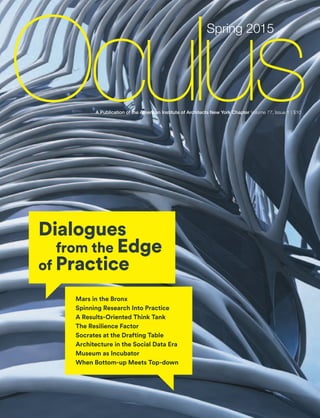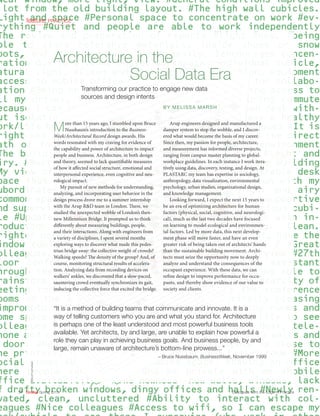Oculus Article
- 1. A Publication of the American Institute of Architects New York Chapter Volume 77, Issue 1 | $10 Spring 2015 Mars in the Bronx Spinning Research Into Practice A Results-Oriented Think Tank The Resilience Factor Socrates at the Drafting Table Architecture in the Social Data Era Museum as Incubator When Bottom-up Meets Top-down Dialogues from the Edge of Practice Dialogues from the Edge of Practice
- 2. feature: PRACTICE Ą°It is a method of building teams that communicate and innovate. It is a way of telling customers who you are and what you stand for. Architecture is perhaps one of the least understood and most powerful business tools available. Yet architects, by and large, are unable to explain how powerful a role they can play in achieving business goals. And business people, by and large, remain unaware of architectureĄŊs bottom-line prowess...Ąą ĻC Bruce Nussbaum, BusinessWeek, November 1999 More than 15 years ago, I stumbled upon Bruce NussbaumĄŊs introduction to the Business- Week/Architectural Record design awards. His words resonated with my craving for evidence of the capability and power of architecture to impact people and business. Architecture, in both design and theory, seemed to lack quantifiable measures of how it affected social structure, emotional and interpersonal experience, even cognitive and neu- rological impact. My pursuit of new methods for understanding, analyzing, and incorporating user behavior in the design process drove me to a summer internship with the Arup R&D team in London. There, we studied the unexpected wobble of LondonĄŊs then- new Millennium Bridge. It prompted us to think differently about measuring buildings, people, and their interactions. Along with engineers from a variety of disciplines, I spent several months exploring ways to discover what made this pedes- trian bridge sway: the collective weight of crowds? Walking speeds? The density of the group? And, of course, monitoring structural results of accelera- tion. Analyzing data from recording devices on walkersĄŊ ankles, we discovered that a slow-paced, sauntering crowd eventually synchronizes its gait, inducing the collective force that excited the bridge. Arup engineers designed and manufactured a damper system to stop the wobble, and I discov- ered what would become the basis of my career. Since then, my passion for people, architecture, and measurement has informed diverse projects, ranging from campus master planning to global- workplace guidelines. In each instance I work itera- tively using data, discovery, testing, and design. At PLASTARC my team has expertise in sociology, anthropology, data visualization, environmental psychology, urban studies, organizational design, and knowledge management. Looking forward, I expect the next 15 years to be an era of optimizing architecture for human factors (physical, social, cognitive, and neurologi- cal), much as the last two decades have focused on learning to model ecological and environmen- tal factors. Led by more data, this next develop- ment phase will move faster, and have an even greater risk of being taken out of architectsĄŊ hands than the sustainable building movement. Archi- tects must seize the opportunity now to deeply analyze and understand the consequences of the occupant experience. With these data, we can refine design to improve performance for occu- pants, and thereby show evidence of our value to society and clients. Architecture in the Social Data Era Transforming our practice to engage new data sources and design intents BY MELISSA MARSH ?ScottLeinweber Dialogues from the Edge of PracticeOculus Spring 201534
- 3. A colleague recently said, Ą°With social media at play, all the time that used to be spent marketing a product will have to be spent making it a great product.Ąą Today, with sensors and mobile apps, we can collect building feedback to better inform client decisions. This work might once have required dozens of engineers, hundreds of volunteers, innumerable hours, and other resources. It is now possible to incorporate real-time, candid input from occupants, using technology to channel this information more seamlessly into our work. With a streamlined discovery process, we can more easily draw upon what we learn in order to inform the path of our design and improve our product. At a moment of more and more availability, transparency, and optimization of data in other fields, architects are increasingly being asked to show evidence that our solutions can and will perform for a variety of occupantsĄŊ requirements. While other professionals speak in terms of product efficacy and performance, architects tend not to, especially in relation to how our work affects people. We must be willing to embrace the data and technological tools at our disposal, from building sensors and digital thermostats, to Twitter and Foursquare data. It is essential for architects to take charge of these performance criteria ĻC to measure or be measured. As consideration of human factors and behaviors in building performance moves to the forefront, it is imperative that we explore new ways to measure and predict these variables. We must ask the questions that help us understand the physical and psychological impacts of space at every scale. We must pursue this both before and after design, leveraging emergent data for new discoveries, and collaborating with neurological and cognitive science to explore the impact of our work. Moreover, these measurable ĻC and describable ĻC impacts of design will include a full sensory repertoire, such as smell, taste, texture ĻC even humidity. In a North America that is mostly built, our role as architects will shift from building new to reshaping. The architectural business model will become more iterative. Each built work will operate less as a finished work and more as a step in a perpetual learning process. Engaging continually with facility managers and community clients, we can collaboratively evaluate how our buildings are working, informed by improved information and public data. Questions of design and human experience extend beyond architecture, and the future of evidence- based architectural design will need to be an interdisciplinary venture. We will need to engage with technologists, sociologists, psychologists, ergonomists, and others in the pursuit of measuring buildings through the lens of human perception and performance. Simultaneously, we must train current and future designers to use data, feedback, and user experience design tools in their practice. (opposite page) Smart build- ings are social buildings: PLASTARC data showing occupant-based building performance assessments in social-media-style. To lead this effort, we must shift our own focus as professionals, while also expanding the definition of Ą°architect.Ąą We need an inclusive rather than exclusive model of the profession: an architectural diaspora composed of many experts. This future definition will be inclusive of many who contribute to the built world, and embrace those who are educated as architects yet deploy their talents elsewhere. Whether they are developing real-estate valuation apps or digital olfactory transmission products, these innovators are expanding the frontier of our profession. < Melissa Marsh is founder and CEO of PLASTARC, a social research, workplace innovation, and real- estate strategy firm serving tenants and owner-occupiers, and collaborating with architecture and design firms. Marsh is a regular contributor to e-Oculus and an organizer of AIANY Professional Practice CommitteeĄŊs Transforming Architectural Practice series. Know that smart buildings are social buildings Measure or be measured Consider user experience (UX) for architecture Leverage current buildings as a full-scale prototype Embrace an architectural diaspora Some observations from the field: Dialogues from the Edge of Practice Spring 2015 Oculus 35



